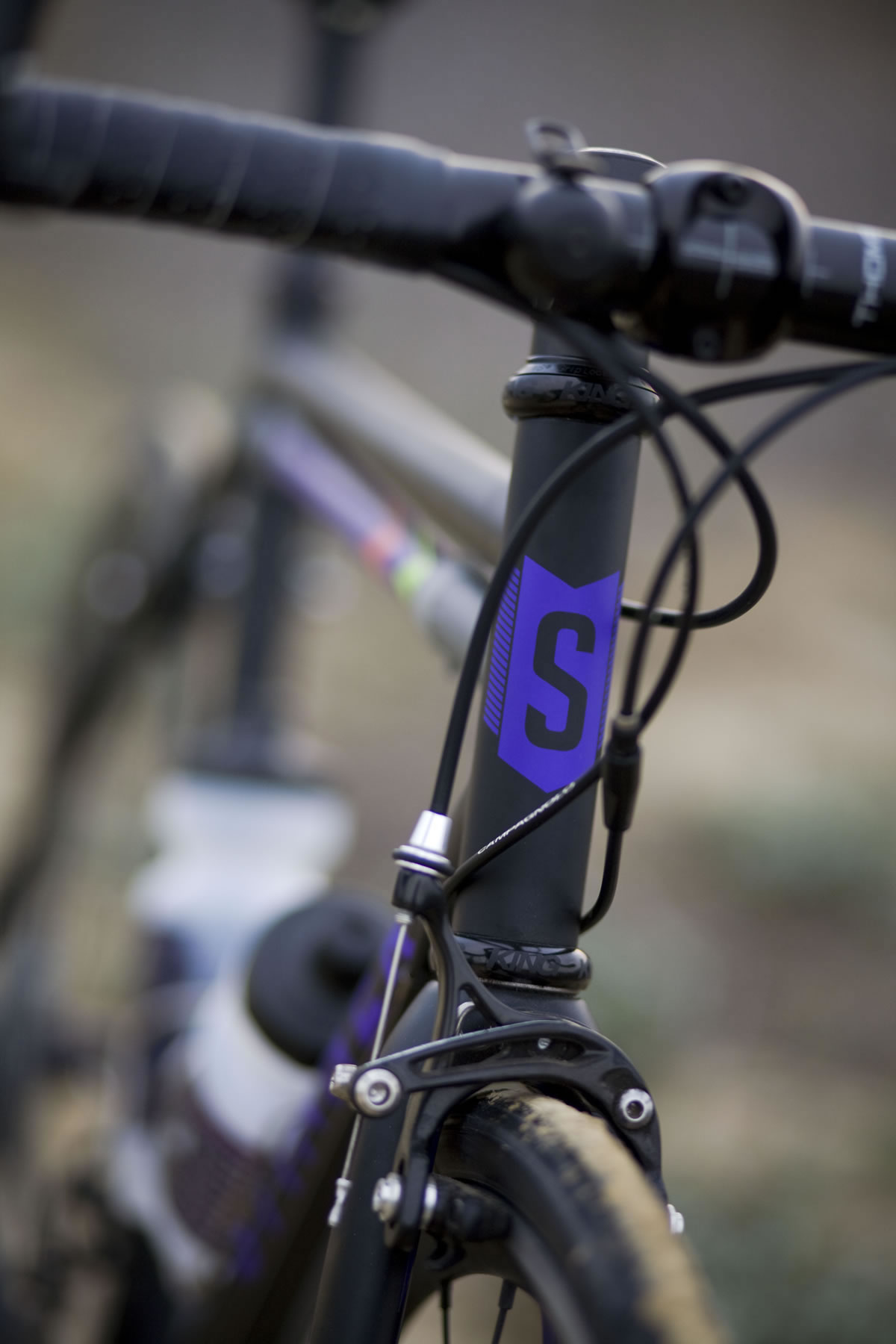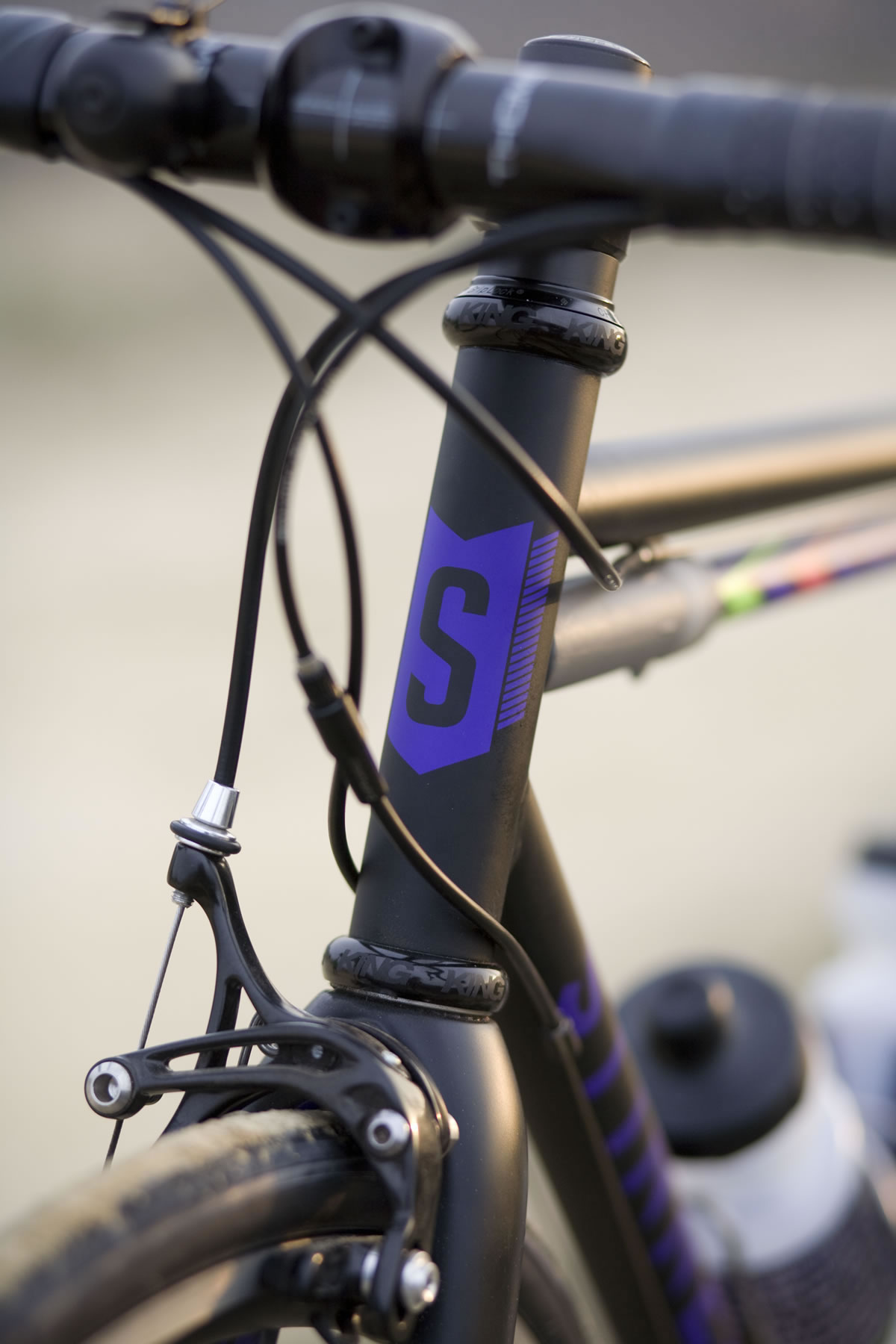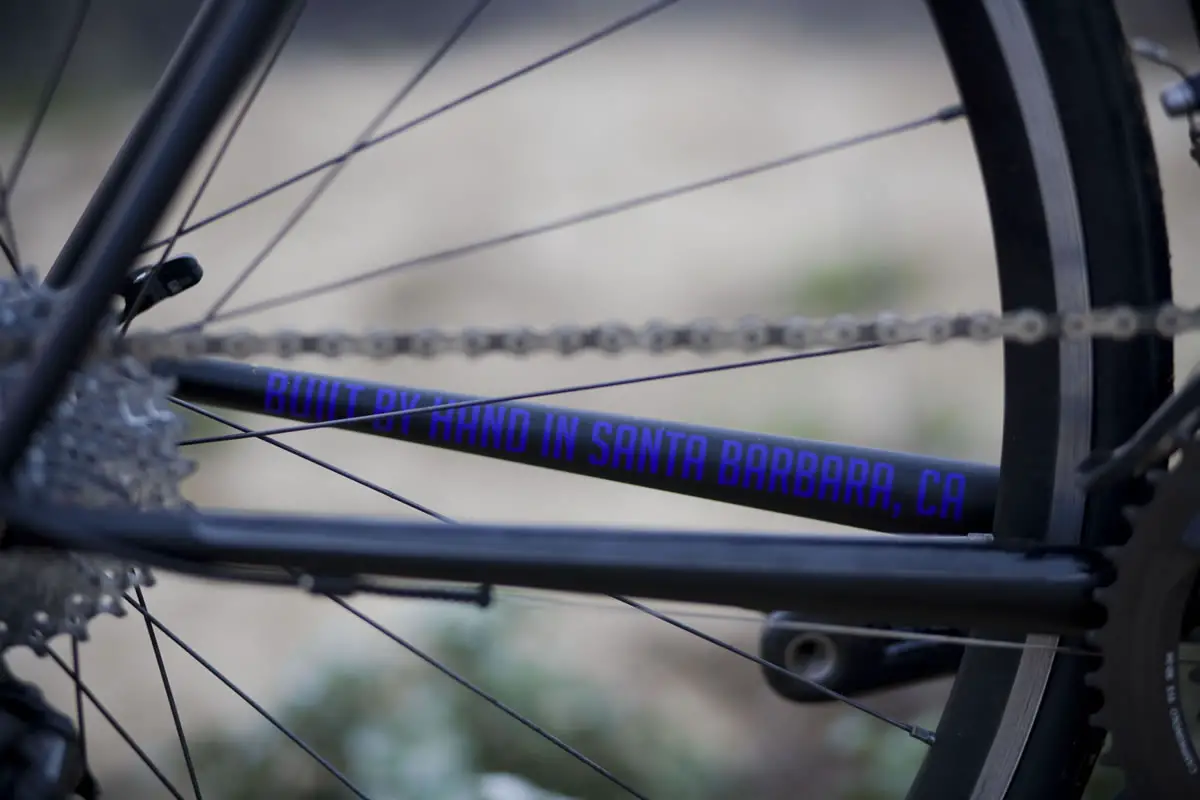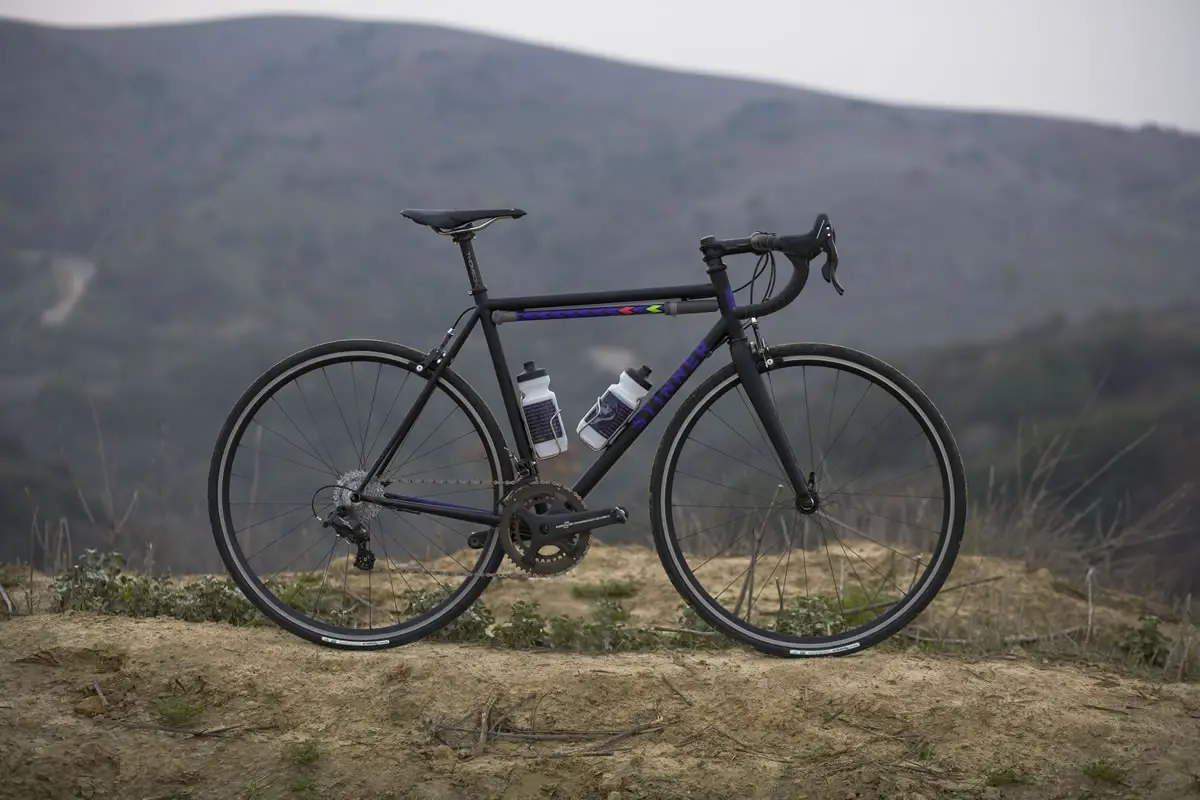BUILDING A CALIFORNIA DREAM BIKE WITH STINNER FRAMEWORKS
WORDS BY CHRIS KLIBOWITZ
PHOTOS BY NICK BRANDEAU
Not too long after Aaron Stinner won the 2012 North American Handmade Bicycle Show (NAHBS) Rookie of the Year award, and started making frames full time, I first sent him an email to inquire about a frame. A friend and fellow journalist had been going on about the topic of ‘how many bikes should you own’ and had said something that resonated with me—own one that was as local as possible. I hadn’t been in Los Angeles, California, that long, and sought ways to further adapt to my new home. This was perfect. Stinner came up on a short list of framebuilders operating in or near LA—there were surprisingly few back then, and not many still today. Even Stinner is about 100 miles away, outside Santa Barbara, California. He had me sold when I read on his website that he was drawn to fabricating in steel by his first road bike—a Reynolds 853 LeMond Zurich—which was the same model as my first, and the bike I always regretted selling. Nothing came of that initial chat except a mental ‘Okay, someday’.
A couple years later, I was chasing stories for another publication, and checked back in on Stinner. I caught him just as he was moving out of his garage and into a dedicated workspace and office, which they dubbed ‘The Goodland Lodge’—a nod to their town’s nickname and the décor of their office space. I drove up and spent a long afternoon with Stinner and his crew, and saw how the whole thing—and he—had matured. No longer just a young guy brazing frames in his garage, Stinner Frameworks now employed a few like-minded folks, all in the pursuit of giving people their dream bikes.

Customer Dreams
The common theme in all of it—every email, every story, every conversation about a bike for me or anyone else—is customer service. Customer satisfaction. Happy customers. It all goes back to the man himself, Aaron Stinner. His name is on the door, and his name is on the downtube, and it is his attitude that drives the company ethos. Every step has been about better servicing customers. He took a framebuilding class in the first place to better serve the customers he was fitting at the shop. When he was taking orders in his garage, the wait time got too long, so he moved the shop and hired help. He is involved in every step of the process, guiding the customer to not only get a dream bike, but also enjoy the process of getting their dream bike.
It’s easy to talk the talk, but how do they walk the walk? The warranty against defect for life is fairly standard, but they also offer another guarantee. If your new Stinner “does not live up to your expectations” then you can return it for a full refund within 30 days. It is a helluva thing to put that in writing, right up front. While you may think that is just confidence, to speak to the folks there reveals that this is a more modest offer—if your bike doesn’t meet your expectations, then in a way, neither did they, and that’s not what they are about.

THE BIKE
Frame
Last spring, I quit my full-time job to stay home with my son. With less room, time and money, it didn’t make sense to be holding onto a big stable of bikes, so I looked to consolidate, and Stinner was my only call. The request was simple: I wanted to build as versatile a road bike as I could—it was going to be my one and only bike—without too deeply compromising my roadie aesthetic. Put simply, I wanted a more-gravel-capable bike that looked like a more full-on roadie.
I headed to the shop with my current bike, and Stinner did a proper fitting on that bike, taking measurements while we discussed what I liked about the bike I was riding, what I didn’t like, and what I wanted from the new one. We discussed the current fit, and even looked at the geometry of another previous bike I liked. A few things were cemented: threaded bottom bracket, straight 1-1/8″ headtube, a sloping—not too much, though—toptube, and room for 28/30c tyres. And lastly, I wanted the paint to match the color scheme and aesthetic of the club I belong to, Kapelmuur Independent.

Within a couple of weeks, I had a draft of the frame. After discussing a few points, it headed to production and I headed off to get the rest of the components on their way to the shop—when at all possible, Stinner prefers to deliver a complete bike. He says the level of satisfaction seems to be higher that way, even telling the story of one excited customer who rode right out the front door, disappearing for a half hour.
Cockpit
American riders are used to seeing a lot of Thomson stuff, and for good reason—they are the workhorse cockpit components. Not the most or least expensive, not the lightest or heaviest. They are quality aluminum parts, made in the USA (except the carbon handlebars) that come in sizes to accommodate any fit. My fit was based around a 0mm setback post and 110mm stem, the most aesthetically pleasing combination, in my opinion. I opted for the Elite X2 stem, their lighter stem with a two-bolt clamp and their standard Elite seatpost. What can you say about stems and posts? They look great, and haven’t broken… The carbon drop bars are a newer product, and one of the first made overseas. Thomson calls them “mid-compact reach and drop” which, along with a slight wing shape on the tops, provides a very comfortable feel from the get-go. Constructed from Toray carbon, they mix different fiber types and layouts to provide stiffness and compliance in all the right places. I do wish they had some flare on the drops, but the added depth makes this less of an issue than on true compact bars.

Gruppo
I’m a Campy guy. I’ve owned bikes with Shimano, SRAM and Campagnolo, and the Campy is the one that always just felt right. The other manufacturers make great products, but Campy is the only one that seems to evoke emotion. I liked my bike with Dura-Ace, but I loved that same bike with Record—Campy makes a bike just better. When confronted with the options, my first inclination was, of course, ‘just get the best, the Super Record’. However, this seemed in conflict with my original versatility thought. The Super Record group is sexy, but at a (very significant) cost—plus any repair of a worn or broken component was going to be $400, minimum.
Given the time and monetary restrictions that drove this project from the start, this was not a smart move. In looking at the other gruppos, the Chorus group jumped at me, and upon researching, I found that the mechanism was the same in 2015 Chorus, Record and Super Record—the only differences were the materials used, with more carbon and titanium found on the more expensive groups. However, this means that replacement costs of Chorus hover around a much more manageable $200—nearly half that of Super Record. Thanks to the mountains all around where I live, which are always calling, I opted for a compact crankset and Campy’s new 11-29 cassette, offering the widest gear range available in its line.
After spending a considerable amount of time on both Record and Super Record over the past few years, I was pleasantly surprised to find little difference in the Chorus group, in fact, the front derailleur might work even better, thanks to heavier (and stiffer) materials, though I still struggle with the new sequence of clicks. The ability to trim helps with the wide gear ratio, but my familiarity with the previous iteration seems to be stuck in my muscle memory. However, the rear shifting is as crisp as I’ve felt in any mechanical group—I often find myself wondering if the shift happened at all!—and the update to the Vari-Cushion hood material only adds comfort to an already easy-to-hold control.
Wheels
I’ve owned the same pair of handbuilt wheels for several years, on a few bikes, built for me by Ryan Morse of Diablo Wheel Works in Pacific Palisades, California. They are Chris King R45 hubs 24h/28h, laced two-cross with DT Revolution spokes to HED Belgium C2 rims. His build was flawless, and they have been nearly bombproof over thousands of miles, and so I chose to keep these as my ‘dirt/gravel’ wheels, thanks to their wider stance, which spreads the tyres a bit. They have 11-29 gearing, for those punchy, loose climbs.
Being a sucker for matching, and keeping with that roadie aesthetic, I also got a pair of Campagnolo Neutron wheels, to complement the Chorus group. Generally, I’m not a fan of pre-built wheelsets, but the Neutrons share more in common with a traditional wheel, using a more standard Sapim spoke. The wheels are engineered to take advantage of their featherweight, by offering some comfort in compliance. I outfitted them with an 11-27 cassette that I had in my tool box, for long road climbs, where I prefer a tighter gear ratio on the low end. On the road, these wheels feel remarkably similar to my King/HEDs, which is about as big of a compliment as I can give to a pair of wheels.

Both pairs of wheels get Campagnolo skewers, a nod to Tullio and perhaps his most important invention. They also get the same rubber: the Panaracer Gravel King 28c. This is my go-to tyre, performing so well on and off the road, that I feel comfortable outfitting all my wheels with it.
The Rest
There are a handful of items that have remained the same on every bike I’ve owned, for years. If it ain’t broke, don’t fix it, right? Speedplay Zero stainless pedals, Fizik Microtek handlebar tape and matching Antares VS saddle make up my contact points. Stainless steel King cages hold my bottles, and a Spurcycle bell helps me alert others to my presence. And then, one of my favorite details, the thing that, upon installation, truly makes a bike like mine: a vintage pair of hard rubber CatEye barends. The Chris King NoThreadSet is among the most iconic and best-looking bicycle components of all time. I’ve had one on every bike I’ve ever owned that could fit one, and specifically chose a standard 1-1/8″ headtube so I could have one on this bike, too.
Oh yeah, the Pump: I made a decision to finally ditch the constant need to carry either CO2 or an ineffective pocket-sized pump, so I took advantage of the pending custom paint job to send Stinner a frame pump—the Topeak MasterBlaster—to be painted. This was among the most satisfying of all my purchases, which is a difficult-to-explain phenomenon. Knowing the rough idea behind the paint that was coming, I simply told them “use those colors and surprise me” with the pump.

The Verdict
Taking delivery of the bike, only several weeks after that last email exchange of the final draft, was an exciting morning. I headed to Santa Barbara early, stopping at Handlebar Roasters for a quick coffee, and rolled into Stinner around 9:00 a.m. to find a bustle already in progress. The paint job is stellar, giving me the touches of my club’s look without compromising Stinner’s own Cali-inspired look. It’s effortlessly both a Stinner and a Muur bike. Despite there being many projects in progress around the shop, Aaron devotes his attention to the task at hand, putting the final fit touches on the bike, making sure it is dialed for me.
It feels great, cementing my belief in his talent for geometry and fit—he’d made some interesting recommendations that required my trust in him, and it paid off. Out riding, it immediately felt like a bike I’d spent hours and hours on, and performed in exactly the manner we discussed. Which is, after all, the draw to a custom builder: you get to dictate how you want the bike to ride, and a good framebuilder makes that happen through tubing choice, geometry and construction.
That’s the dance, isn’t it?







